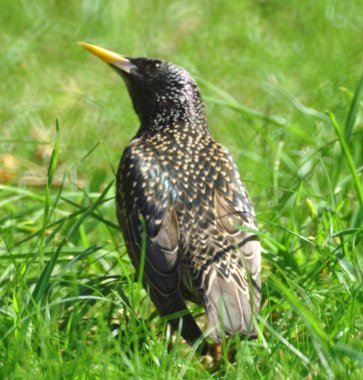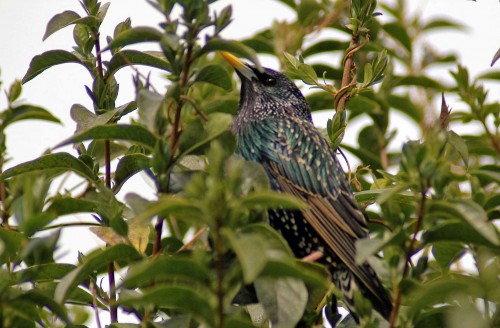Tags
birds of conservation concern, garden birds, house sparrow, house sparrows taking pampas grass, passer domesticus, starling
I was pleased to see House sparrows once again topped this year’s list of the RSPB Big Garden Bird Watch in England, Wales and Scotland, but we shouldn’t get complacent, they’re still on the ‘Red List’ of birds requiring the highest conservation priority, along with other species needing urgent action.
Over the past couple of weeks I have spent some afternoons dog-sitting for my daughter, which has given me the opportunity to catch up with the little flock that regard her garden, together with those of the immediate neighbours’ as their territory.
I don’t blame them for settling here, they have everything they need to live as easy and productive life as it is possible for birds to enjoy. Throughout the year they come and go throughout the day, enjoying the bounty of well-stocked bird feeders, a pond in which to bathe and hedges to provide cover and perching places. Every evening the whole community returns to roost safely within the prickly pyracantha hedge. Now they are well into the throws of nesting. Earlier on they began refurbishing last year’s nests or rebuilding any lost through winter pruning. There are perhaps 4-5 nests, sited close together, although the level of noise that emanates from within sounds like there should be more. A couple more pairs prefer the loftier location of the eaves above the third floor at the front of the house.
In the breeding season the dominant birds leave the safety of the hedges and perch prominently on the highest points of shrubs to proclaim their territory, although the individual territory of the male House Sparrow really only consists of the nesting hole and a very small area around it, which is defended vigorously.
Females judge males on the vigor of his behaviour and also by his plumage. The black bib and how it is displayed is hugely important for him and size matters. Apparently males with small bibs can be induced to behave more boldly if they have bigger and blacker bibs painted on them!

Dominant females join their partners, but tend to stay slightly lower down and prefer a little more cover
Every year, when the nests are built or refurbished, the sparrows systematically strip the soft fluffy seed heads of the pampas grass that grows in a neighbouring garden. I spent ages one afternoon watching them as they returned repeatedly to strip the stems and carry off the fronds. I assume they use the fluffy parts to line their nests, but wonder if there are seeds to eat too? I find this behaviour fascinating and have witnessed it in South Wales where pampas was growing and also in our garden in Spain. In each location they begin working on the plant on the same day, arriving sometimes in numbers, males and females and set to, detaching the fronds and carrying them off a beakful at time. The harvest continues over a few days until the stems are left bare.
A Starling pair are nesting in one of the chimney pots and they too enjoy the feeding and bathing facilities, also pausing to dry out on perched on the fence or at the top of the hedge. Still one of our commonest garden birds, its decline elsewhere makes it too a Red List species.
The bird in the photographs below is the male of the pair, identified by the blue colouration at the base of his bill; the female has a similar patch that is coloured pink.
The male sings beautifully, sometimes from up on the roof but also from the fence and the top of the hedge. His mate doesn’t get out much at the moment, so must be sitting on eggs.

Starling female has a pink patch at the base of her bill
PS: The pampas grass is now just a collection of bare dry stems!














Thank you Pat, I’m glad you liked the photographs, I always try to present my subjects as and where I see them behaving naturally, so they’re never ‘staged’ and good shots are more down to luck than skill! Do you have House Sparrows in your locality? I know they are not well received in many places in North America.
LikeLike
Beautiful photography! You know how to see through a lens. Very informative post!
LikeLike
Enjoyed your descriptive details and the matching images, Theresa. Intriguing to see the nesting behaviour of the sparrows – those pampas grass fronds look nice and soft. Interesting to note that House Sparrows were brought into SA in colonial times and are now plentiful and considered a pest – impact aggressively on the local bird population. Ironic that they are on the red list in their homespace. The starlings used to be pretty common too?
LikeLike
Thank you. I too find the ‘pampas plucking’ fascinating as I have witnessed it in Spain & S & N Wales, but it doesn’t seem to happen everywhere the birds & plant occur in the same place. H Sparrows originated in the Middle East, spreading to Europe along with agriculture & in the UK, historically have met with the same hostility & persecution as elsewhere in the world. Numbers here peaked in the ’70s, now down by 68%, mostly gone from towns & cities.Same with starlings, still fairly common here, but not in the numbers they used to be in towns & cities. I didn’t realise you had problems with them in SA – how do they impact detrimentally on indiginous species?
LikeLike
They’re quite an aggressive species and unfortunately they outcompete the more vulnerable local species. Guess they’re just too successful. They come up as Invasive species – Category Three here in the Western Cape. So we’re seeing more of one species whereas the variety of local species has disappeared. Mallard ducks are another species causing issues by interbreeding with the local yellow billed ducks and compromising genetic integrity.
LikeLike
Lovely to see the sparrows. We don’t see them in our woodland or in London but my daughter says she has become me watching our London garden birds! She had a nest of robins right close to the house. Am glad as these experiences matter! Here the birds still elude me but the wild boar and mongoose didn’t!
LikeLike
Thank you. You are clearly too ‘countrified’ for House Sparrows in your part of Spain, have you seen them in villages or towns you visit? You may get to see them again in London as there are lots of schemes afoot to re-establish them there. I’m pleased you’re managing to train your daughter- mine is not so interested, but I think she likes to see the birds in her garden more than she lets on! Seeing birds in woodland is notoriously difficult. I used to coax some out by putting feeders out, buying seed sold for cage birds. Feeding wild birds is not the norm in S.Spain, where they are more likely to eat them or put them in a tiny cage to sing for them & our gardener thought I was ‘loca’! Hope the wild boar stay out of your heurta!
LikeLiked by 1 person
Thanks, yes we don’t wonder that the birds need to stay hidden. The barber of Aracena seems to have a collection of goldfinches. Can’t understand it but think some attitudes are changing, slowly?
LikeLike
Last year, after about two years of feeding the, I had built up ‘my’ sparrows in my small garden to an astonishing number, occasionally reaching 70. Here’s a picture of some of them: https://www.flickr.com/photos/paul_seligman_cardiff/20985169140/in/photolist-94fURZ-5MyMDj-78wv6i-xYotF3-d4bX1h-vXraSA-v2c7fP
Currently there’s a maximum of around 20, so we’ll see if the post-breeding numbers can top last year’s.
LikeLike
Thanks for commenting Paul and it’s good to hear your sparrows are thriving. The numbers in my daughter’s garden increase dramatically once breeding gets underway as each nesting pair raises at least two broods each spring/summer. They stick together then and return to roost in the hedge during winter, then they must disperse as the number of nesting pairs in this particular spot doesn’t seem to increase notably. There are more birds to be found in the immediate locality though. Something to do with available resources?
LikeLike
Your posta are wonderful and I learn something new from every one, such as how to tell a male starling from a female! I’m surprised sparrows are on the red list. What about starlings? We used to have a mob that would descend on our garden, noisy and rumbunctious – like a group of over-excited teenagers. But they disappeared a few years ago.
LikeLike
Thank you for the kind comments Ruth. I think a lot of people don’t realise that house sparrows have disappeared from a lot of places where they used to be present, such as in town squares and public parks, which is why they are on the list. I have amended the post now to read that yes, starlings are on the red list too, as again they appear in gardens but have disappeared from other traditional haunts. Also added a pic of a female with her pink patch!
LikeLike
What a nice post. Thankfully the 30 plus house sparrows in our mid-Wales garden don’t seem interested in our pampas grass, but then they have sheep in the field opposite so have a stready supply of fleece. We fed them (and other birds) regularly and my husband says that many of them live in the eaves of our neighbour’s roof and in their garage. They used to share the garage with a dog – neither the dog nor the sparrows minded each other.
How nice to be able to tell the gender of starlings as we usually get a stragler that’s lost track of its flock later in the year and we’ve never been able to tell what it is.
LikeLike
Thank you Val, so glad you enjoyed it. I can understand why your sparrow flock would find sheep’s wool a superior nest liner to pampas! I never minded sharing mine as it’s not taken till it’s getting past its best. I think its use must be an instinctive thing going back to their origins in Africa. Good luck with the starling identification – I’ve added a photo of a female to the blog so you can see the difference. Another difference is that in winter the white or buff spangles on the dark plumage are more marked in the female than the male. Not much help if there’s only one to look at though!
LikeLiked by 1 person
Thank you!
LikeLike
Wonderful blog, Theresa. I learnt a lot about sparrow behaviour.
LikeLike
Thank you. As you know, I love House sparrows and feel lucky to have them close enough to be able to watch them getting on with their everyday lives. There’s a lot more to them than first meets the eye!
LikeLiked by 1 person